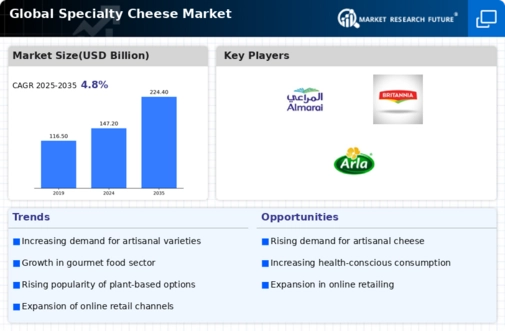Market Analysis
In-depth Analysis of Specialty Cheese Market Industry Landscape
The specialty cheese market is characterized by a dynamic interplay of factors that influence both the supply and demand sides of the industry. One of the primary drivers propelling the growth of the specialty cheese market is the increasing consumer interest in diverse and high-quality cheese options. Specialty cheeses, known for their unique flavors, textures, and production methods, have gained popularity among consumers seeking novel and indulgent culinary experiences. The market has witnessed a shift in preferences as consumers explore artisanal and premium cheese varieties beyond conventional options. Geographical variations play a significant role in shaping the market dynamics of specialty cheese. Different regions have distinct cheese-making traditions and cultural influences, contributing to the variety of specialty cheeses available in the market. For example, European countries are renowned for their centuries-old cheese craftsmanship, while regions like the United States are witnessing a surge in artisanal cheese production. This diversity creates a complex market landscape, prompting specialty cheese producers to adapt their offerings to cater to regional tastes and preferences. The culinary and gastronomic sectors significantly contribute to the demand dynamics of the specialty cheese market. As the culinary landscape evolves, chefs and food enthusiasts seek unique ingredients to create innovative and gourmet dishes. Specialty cheeses, with their diverse flavor profiles and textures, have become integral components of upscale menus and culinary creations. The influence of culinary trends on consumer preferences further drives the demand for specialty cheeses in both retail and foodservice sectors. The retail landscape and distribution channels are integral to the market dynamics of specialty cheese. Specialty cheeses are distributed through various channels, including specialty cheese shops, gourmet retailers, farmers' markets, and supermarkets. The visibility and accessibility of specialty cheese brands in these channels impact consumer awareness and purchasing decisions. Additionally, the rise of e-commerce has provided consumers with convenient access to a wide variety of specialty cheeses, contributing to the global reach of niche and artisanal producers. Competition within the specialty cheese market is shaped by factors such as flavor profiles, production methods, brand recognition, and packaging. Artisanal and small-scale producers differentiate their products by offering unique and handcrafted cheeses with distinct characteristics. Established brands leverage their reputation and expertise to maintain market share, while marketing strategies highlighting the craftsmanship, terroir, and heritage of specialty cheeses contribute to brand visibility and competitiveness. Government regulations and quality standards significantly influence the market dynamics of specialty cheese. Compliance with stringent regulations ensures the safety and quality of specialty cheeses, particularly in regions where protected designation of origin (PDO) and protected geographical indication (PGI) labels contribute to authenticity and consumer trust. Adherence to these standards is crucial for specialty cheese producers to gain market acceptance and protect the integrity of their products. Consumer trends towards health and wellness also impact the market dynamics of specialty cheese. While indulgence remains a key driver for specialty cheese consumption, there is a growing interest in health-conscious choices. Producers responding to these trends may introduce specialty cheeses with functional benefits, such as those containing probiotics or lower fat content, aligning with consumer preferences for both taste and nutritional considerations.







Leave a Comment